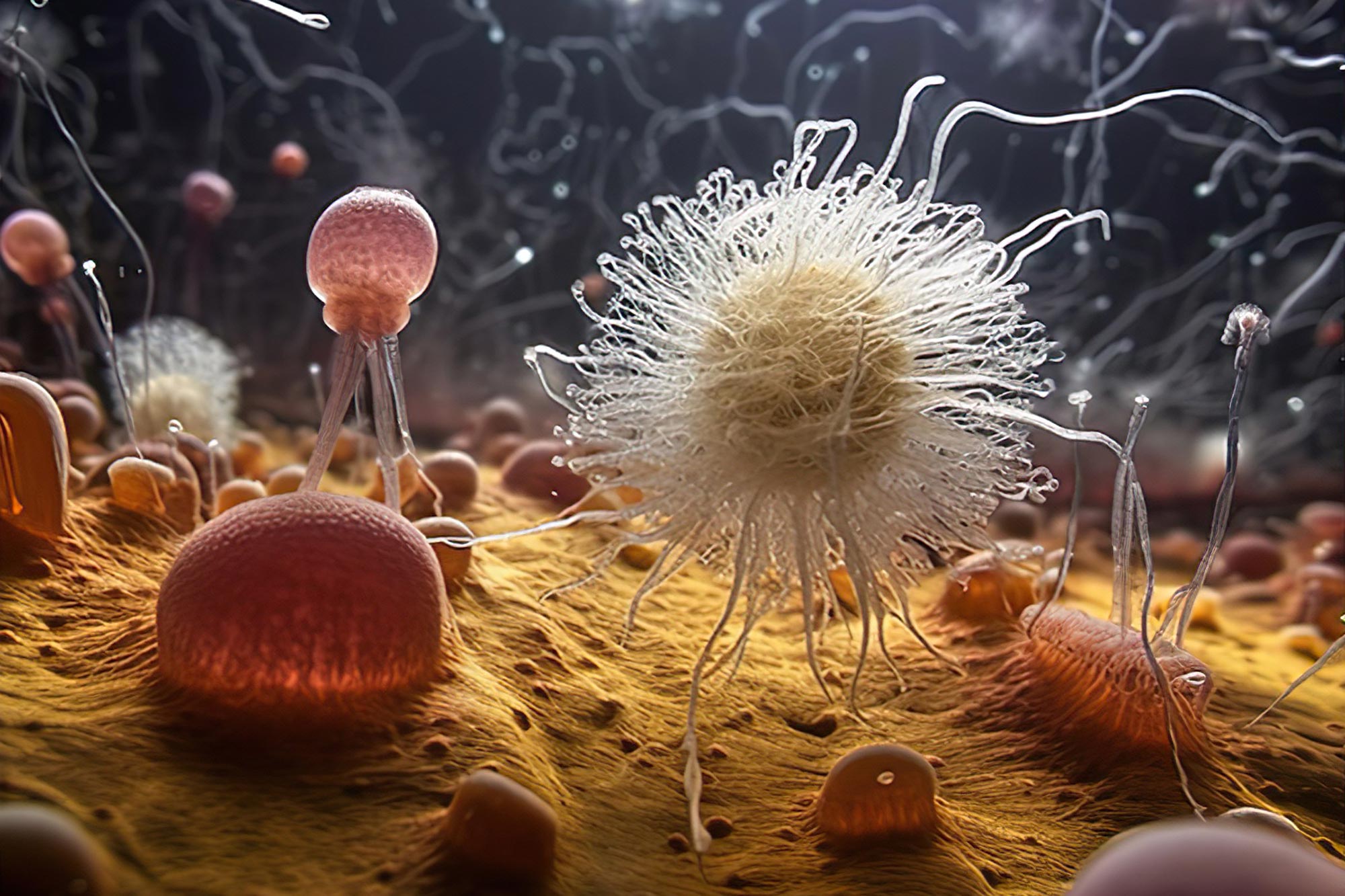par

Imaginaire d’artiste d’un groupe d’eucaryotes primitifs du « Protosterol Biota » vivant sur un tapis bactérien au fond de l’océan. Basés sur des fossiles moléculaires, les organismes Protosterol Biota vivaient dans les océans il y a environ 1,6 à 1,0 milliard d’années et sont nos plus anciens ancêtres connus. Crédit : Organisé le MidJourney par TA 2023
Une équipe de recherche multinationale a découvert d’anciens protostéroïdes dans les roches, indiquant que la vie complexe existait il y a 1,6 milliard d’années. Ces molécules fournissent un nouvel aperçu de l’évolution de la vie complexe et réconcilient les divergences entre les archives fossiles traditionnelles et lipidiques.
Il s’avère que le dossier nouvellement découvert de soi-disant protostéroïdes était étonnamment abondant tout au long du Moyen Âge de la Terre. Les molécules primordiales ont été produites à un stade précoce de la complexité des eucaryotes – étendant le record actuel des stérols fossiles au-delà de 800 et même 1 600 millions d’années. Les eucaryotes sont un terme donné au règne de la vie comprenant tous les animaux, plantes et algues et sont séparés des bactéries en ayant une structure cellulaire complexe qui comprend un noyau, ainsi qu’un mécanisme moléculaire plus complexe.
« Le point culminant de cette découverte n’est pas simplement une extension de l’enregistrement moléculaire actuel des eucaryotes », explique Christian Hollmann, l’un des co-scientifiques du Centre de recherche allemand pour les géosciences (GFZ) à Potsdam. « Étant donné que le dernier ancêtre commun de tous les eucaryotes modernes, y compris nous, les humains, était probablement capable de produire des stérols modernes » réguliers « , il est probable que les eucaryotes responsables de ces signatures rares appartiennent au tronc de l’arbre phylogénétique. »

Benjamin Nettersheim, l’un des principaux auteurs de l’étude, examine les cartes élémentaires et moléculaires à super-résolution d’échantillons de roche vieux de 1,64 milliard d’années analysés dans le laboratoire d’imagerie moléculaire géobiologique du MARUM. Crédit : MARUM – Centre d’écologie marine, Université de Brême ; à Descamps
Cette « souche » représente la lignée ancestrale commune qui était le précurseur de toutes les branches vivantes des eucaryotes. Ses représentants sont éteints depuis longtemps, mais les détails de leur nature peuvent éclairer davantage les circonstances entourant l’évolution de la vie complexe. Bien que des recherches supplémentaires soient nécessaires pour évaluer quel pourcentage de protostéroïdes peut avoir une source bactérienne rare, la découverte de ces nouvelles molécules non seulement réconcilie les archives géologiques des fossiles traditionnels avec celle des molécules de graisse fossile, mais donne un aperçu rare et sans précédent du monde. .perdue de l’ancienne vie. La disparition compétitive des eucaryotes du groupe souche, marquée par la première apparition de stromaux fossiles modernes il y a environ 800 millions d’années, peut refléter l’un des événements les plus durables de l’évolution d’une vie de plus en plus complexe.
ajoute Benjamin Nittersheim de Marom, Université de Brême, co-auteur de l’étude avec Jochen Brooks de[{ » attribute= » »>Australian National University (ANU) – “due to potentially adverse health effects of elevated cholesterol levels in humans, cholesterol doesn’t have the best reputation from a medical perspective. However, these lipid molecules are integral parts of eukaryotic cell membranes where they aid in a variety of physiological functions. By searching for fossilized steroids in ancient rocks, we can trace the evolution of increasingly complex life.”

Dr. Nettersheim inserts a thin section and rock slices of 1.64 billion-years old rocks into the 7T solariX XR FT-ICR-MS equipped with a MALDI source at the Geobiomolecular Imaging Laboratory at MARUM. As part of ongoing research into mid-Proterozoic biomarker signatures at MARUM, GFZ and the Australian National University, Dr. Nettersheim aims to zoom into the cradle of eukaryotic life in unprecedented resolution. Credit: MARUM – Center for Marine Environmental Sciences, University of Bremen; V. Diekamp
Nobel laureate Konrad Bloch had already speculated about such a biomarker in an essay almost 30 years ago. Bloch suggested that short-lived intermediates in the modern biosynthesis of steroids may not always have been intermediates. He believed that lipid biosynthesis evolved in parallel with changing environmental conditions throughout Earth history. In contrast to Bloch, who did not believe that these ancient intermediates could ever be found, Nettersheim started searching for protosteroids in ancient rocks that were deposited at a time when those intermediates could actually have been the final product.
But how to find such molecules in ancient rocks? “We employed a combination of techniques to first convert various modern steroids to their fossilized equivalent; otherwise, we wouldn’t have even known what to look for,” says Jochen Brocks. Scientists had overlooked these molecules for decades because they do not conform to typical molecular search images. “Once we knew our target, we discovered that dozens of other rocks, taken from billion-year-old waterways across the world, were oozing with similar fossil molecules.”
The oldest samples with the biomarker are from the Barney Creek Formation in Australia and are 1.64 billion years old. The rock record of the next 800 million years only yields fossil molecules of primordial eukaryotes before molecular signatures of modern eukaryotes first appear in the Tonian period. According to Nettersheim “the Tonian Transformation emerges as one of the most profound ecological turning points in our planet´s history“. Hallmann adds that “both primordial stem groups and modern eukaryotic representatives such as red algae may have lived side by side for many hundreds of millions of years”. During this time, however, the Earth’s atmosphere became increasingly enriched with oxygen – a metabolic product of cyanobacteria and of the first eukaryotic algae – that would have been toxic to many other organisms. Later, global “Snowball Earth” glaciations occurred and the protosterol communities largely died out. The last common ancestor of all living eukaryotes may have lived 1.2 to 1.8 billion years ago. Its descendants were likely better able to survive heat and cold as well as UV radiation and displaced their primordial relatives.
“Earth was a microbial world for much of its history and left few traces,” Nettersheim concludes. Research at ANU, MARUM and GFZ continues to pursue tracing the roots of our existence – the discovery of protosterols now brings us one step closer to understanding how our earliest ancestors lived and evolved. Shooting at the ancient rocks with a laser coupled to an ultra-high resolution mass spectrometer in MARUM’s globally unique Geobiomolecular Imaging Laboratory, Dr. Nettersheim and his international collaborators aim at zooming into the cradle of eukaryotic life in unprecedented resolution to further improve our understanding of our early ancestors in the future.
Reference: “Lost world of complex life and the late rise of the eukaryotic crown” by Jochen J. Brocks, Benjamin J. Nettersheim, Pierre Adam, Philippe Schaeffer, Amber J. M. Jarrett, Nur Güneli, Tharika Liyanage, Lennart M. van Maldegem, Christian Hallmann and Janet M. Hope, 7 June 2023, Nature.
DOI: 10.1038/s41586-023-06170-w
Participating Institutions:
- Research School of Earth Sciences, The Australian National University, Canberra, Australia
- MARUM – Center for Marine Environmental Sciences, University of Bremen, Bremen, Germany
- Faculty of Geosciences, University of Bremen, Bremen, Germany
- Université de Strasbourg, CNRS, Institut de Chimie de Strasbourg, Strasbourg, France
- Northern Territory Geological Survey, Darwin, Australia
- German Research Center for Geosciences (GFZ), Potsdam, Germany
MARUM produces fundamental scientific knowledge about the role of the ocean and the ocean floor in the total Earth system. The dynamics of the ocean and the ocean floor significantly impact the entire Earth system through the interaction of geological, physical, biological and chemical processes. These influence both the climate and the global carbon cycle, and create unique biological systems. MARUM is committed to fundamental and unbiased research in the interests of society and the marine environment, and in accordance with the Sustainable Development Goals of the United Nations. It publishes its quality-assured scientific data and makes it publicly available. MARUM informs the public about new discoveries in the marine environment and provides practical knowledge through its dialogue with society. MARUM cooperates with commercial and industrial partners in accordance with its goal of protecting the marine environment.





